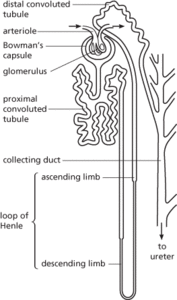The excretory unit of the vertebrate kidney (see illustration). Many constituents of the blood are filtered from the glomerulus into the Bowman’s capsule at one end of the nephron. The glomerular filtrate passes along the length of the nephron and some of its water, plus some salts, glucose, and amino acids, are reabsorbed into the surrounding blood capillaries (see proximal convoluted tubule; loop of henle; distal convoluted tubule). More water is reabsorbed in the collecting duct, and the resulting concentrated solution of nitrogen-containing waste matter (urea in most mammals) plus inorganic salts drains from the collecting ducts of the nephrons and is discharged as urine into the ureter. The kidneys of birds and mammals contain two types of nephrons: juxtamedullary nephrons, which have a long loop of Henle extending deep into the kidney medulla, and a glomerulus in the inner cortex; and cortical nephrons, which have the glomerulus in the outer cortex and a relatively short loop of Henle. Of the one million or so nephrons in the human kidney, some 85% are cortical nephrons, with the remainder being juxtamedullary nephrons. The latter are essential for producing urine that is hyperosmotic relative to body fluids, and their proportion increases with the need to conserve body water, e.g. in desert-dwelling mammals. Birds also need to conserve water and have juxtaglomerular nephrons in their kidneys, whereas other reptiles have only cortical nephrons, as do freshwater fishes and amphibians. Marine fishes have much smaller kidneys with fewer nephrons, whose main function is to excrete ions taken in by drinking seawater. Osmoregulation is augmented by chloride secretory cells in the gills of such fishes.

Structure of a single nephron
- Carnegie Observatories
- Carnian
- Carnivora
- Carnivora(cohort Ferungulata, superorder Ferae)
- carnivore
- carnivorous plant
- carnosaur
- Carnot cycle
- carnotite
- Carnot, Lazare Nicolas Marguerite (1753–1823)
- Carnot, Nicolas Leonard Sadi
- Carnot, Nicolas Léonard Sadi (1796–1832)
- Carnot principle
- Caro, Joseph (1488–1575)
- Carol I (1839–1914)
- Carol II (1893–1953)
- Caroline of Ansbach (1683–1737)
- Carolingian empire
- carotene
- carotenoid
- Carothers, Wallace Hume
- Carothers, Wallace Hume (1896–1937)
- carotid artery
- carotid body
- carotid sinus